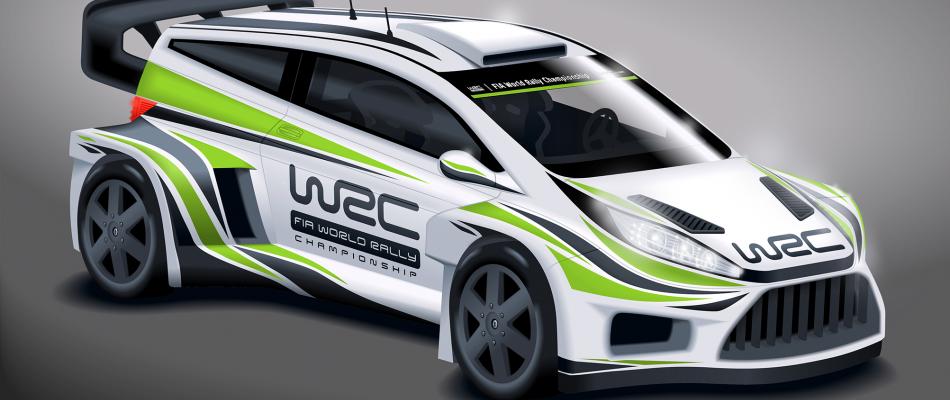380 horsies and meaner looks? Sure!

We’re on a roll with the good news around here, aren’t we? By around here I mean in and around the World Rally Championship. We had some fantastic battles recently, Toyota is coming and Hyundai confirmed they are going to build an R5 car, while Citroën is again thinking about luring Sebastien Loeb back to rallying and Volkswagen, well, Volkswagen are just winning things. Another addition to this stream of good news is the confirmation of “The principles of the technical and homologation regulations for the 2017-2019 WRC car” by FIA’s World Motor Sport Council.
It’s all we ever wanted and more, especially if all this ends up with a solid, engaging and entertaining set of rules and regulations, boosting the popularity and awesomeness of the WRC. On one hand, we need stability and we need costs to remain reasonable (to a point), but on the other hand, we want to see growth. One way to do that is to leave the basic rules intact, but at the same time, give manufacturers more freedom in designing visual elements of the cars. Thankfully, FIA did not stop there, so we did not just get a licence to stick new wings and bumpers on existing machines, but we also got an engine power increase. So, ideally, cars will end up looking more elaborate, aggressive and thus more attractive to the spectators, but they will also be faster and perhaps, just perhaps, a bit more harder to tame. Oh, yes, center electronic diffs are back too. WRC cars will be allowed to shed a healthy amount of kilograms, 25 in total, and expect to see all kinds of openings and intakes, exhausts and whatnots everywhere.

All this will, I’ve zero doubts, improve the show and bring rallying even closer to its roots, but keep in mind these are all principles and ideas, upon which the final rules will be built. They are great nonetheless, because they’re not trying to fix what ain’t broken, instead, they’re focusing on building upon the solid foundations, creating cars which will be more exciting to watch and hopefully drive. I do hope nobody makes any mistakes from now on, whether it’s teams, the FIA or the promoters, because we have finally found our way out of the woods.
Keep investing time, money and efforts into the WRC and it will deliver, big time.
Special note: Never, ever, EVER let your guard down when it comes to safety, WRC organizers. Ever. This definitely is the next big thing worthy of a wider discussion, because we’re going to see even more spectators on stages in the future and very, very strict rules and standards must be applied and maintained. We must minimize risks, whenever and wherever possible.
Here’s an excerpt from FIA WMSC conclusions.
FIA World Rally Championship
The principles of the technical and homologation regulations for the 2017-2019 WRC car were approved by the World Motor Sport Council. The intention behind the new regulations is to produce a car with a far more dynamic and distinct appearance that exhibits character and diversity. The highlights are:
Engine
– Powered increased to 380hp
– 36mm maximum diameter for the turbo restrictor
– Maximum 2.5b absolute turbo pressure
Body
– Free zone defined around the body shell of the production car to create a maximum WRC car width of 1875mm and greater overhang front and rear
– Greater freedom on the lateral parts of the front bumper, with potential for additional aero devices ahead of the front wheels. Openings may also be cut-out on the fender surface
– Bigger and more visible fixed rear wing
The overall weight of the car will be reduced by 25kg, there will be a return to an electronically-controlled centre differential and the overall homologated length of the car must be greater than or equal to 3.9 metres.
TEAM BOSSES & DRIVERS COMMENT
“I think that the ideas for the look and performance of the 2017 car are great news,” said Volkswagen Motorsport’s double FIA World Rally Champion Sébastien Ogier. “As a racing driver you are always looking for more performance. I think the larger wing and new aerodynamics will give the car a bit more downforce, more grip and more speed going into the corners. This is also good for the show, because the extra power will definitely make the driving more spectacular for the fans. And it will also make the car look a bit more aggressive with a wider body – I am really looking forward to seeing the next generation of the Polo R WRC.”
Yves Matton, Director of Citroën Racing, said: “We are very excited with the new look of the world rally car from 2017. It is difficult for us to say if we will commit to this Championship at that time, but all I can say is that the cars will look absolutely amazing. They will bear more technological aspects and lead the audience to their dream. The wings and the bumpers will be redesigned in order to attain a larger maximum width, and a larger rear wing will also bring a more aggressive look to the vehicles. We believe this will create more excitement for the public in the stages, but they will still be able to recognise the road car model they can drive on a day-to-day basis.”
Michel Nandan, Team Principal at Hyundai Motorsport: “WRC has benefited from stable regulations for the past few years, which have been good for companies like Hyundai coming into the sport. The current rules have afforded us flexibility and ease in adapting the standard road car to develop it into a WRC specification. The changes for 2017 are, however, even more ‘manufacturer appropriate’ in that we have even more freedom to work on the car, for example on the suspension, and to push the design envelope of the car, which will consequently be more powerful, larger and look more aggressive. All in all, it will be another positive step forward to improve the value of the WRC and to take the sport into an exciting new era.”
M-Sport Managing Director, Malcolm Wilson OBE: “These new regulations mark the start of an exciting new era for the FIA World Rally Championship. Not only will the 2017 cars look a lot more spectacular, but we will also see an increase in power and performance. The concept really does remind me of the Group B days. When you combine the exhilaration of that era with the fantastic safety measures that the FIA have worked to implement, this marks the start of a thrilling new chapter for the WRC. Although the cars will look completely different and there will be some substantial work on the bodyshell, a number of key components can be enhanced and carried over from our current car. From a financial point of view, a number of parts that we are currently working to develop can be taken a step further and the whole team is really looking forward to getting started on this new project.”



